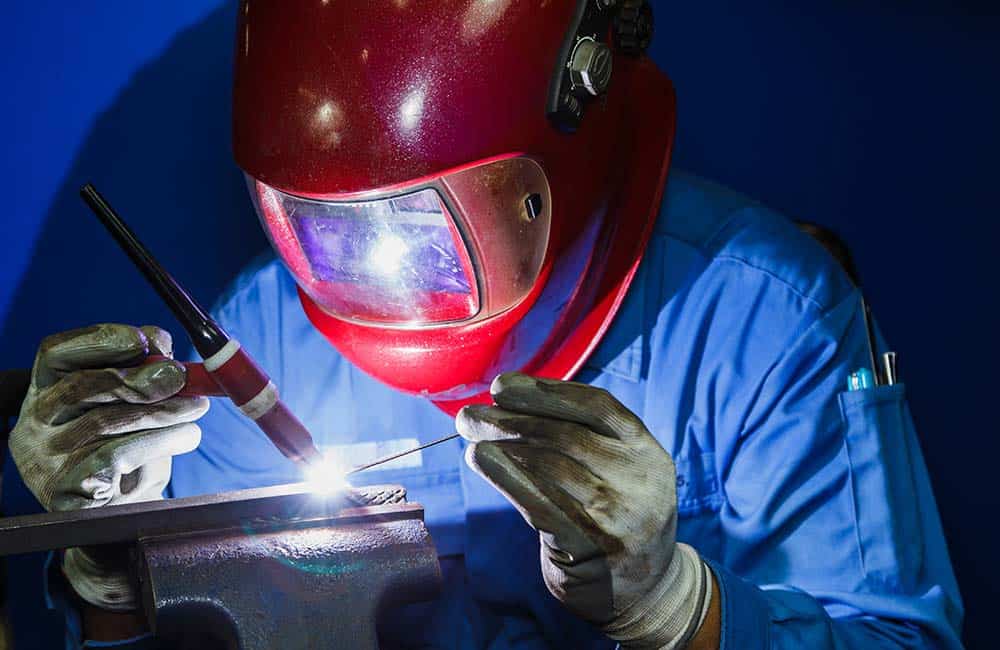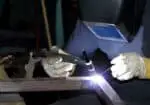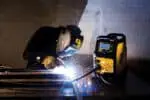
There are different welding types and each type uses only particular types of shielding gases!
Using the wrong shielding gas will create unnecessary problems in your welding process and will lead to defective weld.
TIG welding uses tungsten electrode and therefore you have to only use the shielding gases that do not react with the tungsten electrode.
The best choice of shielding gas for TIG welding is 100% pure Argon Gas because argon protects the weld pool from oxidisation and also does not absorb nitrogen. Also, argon ionizes very easily and provides a stable electric arc for welding and gives out a narrow arc cone, thus making it easier for you to weld!
Besides argon, you can also use some other gases as well, which I will be discussing in detail in this article and to find out about them let’s plunge directly into the details…
Gases Used in TIG Welding
There are various gases found in a welding shop. However, only a few of these can be used when TIG welding. It is important to remember that TIG electrodes are not consumable and that your weld pool will be fed by hand.
This is important because you don’t want your Tungsten electrode to be affected by the wrong gas. It is fundamental to use gases that do not react with the electrode.
Noble Argon (Ar) is the favorite inert gas used for TIG welding because it is quite versatile. It is the most common atmospheric gas after oxygen and nitrogen.
As it is completely inert, it will not react with other substances. Even though it is the third most common atmospheric gas, it only accounts for approximately 0,9% of our atmosphere.
The only source of commercial argon is as a by-product in the industrial separation of air. Since it occupies such a small part of the atmosphere, it is more costly than nitrogen.
This gas can be used for welding numerous metals like aluminum, steel, and stainless steel. Pure 100% Argon is the ideal and preferred shielding gas in TIG welding to protect your weld pool from oxidation and any absorption of nitrogen. Pure Argon should be used regardless of the metals you are welding.
As it is heavier than air, it will only require a low flow rate. Since it ionizes with ease, it will provide a stable electric arc for your welding. It also gives a narrow arc cone, together with narrow penetration affording you more precision when welding.
Helium (He) can be added to argon for increased penetration and weld pool fluidity. A controlled amount of helium added to argon will give you a better heat transfer because Argon has poor thermal conductivity.
Because helium is lighter than air, it will require larger flow rates. Translated you would use more helium when welding making it less economic. It also does not ionize easily so the arc will require a higher voltage to start. The start will also be less stable causing spatter with welding some metals.
On the positive side, it has high thermal conductivity, unlike Argon. The combination of Argon and Helium will compensate for any drawbacks in the individual gases.
Other inert gases such as krypton, neon, or xenon are not used in TIG welding because they are both quite rare and quite expensive.
Semi-Inert Gases
Oxygen should not be used by itself. It may be combined with Argon but should be limited to two to five percent only to improve the stability of the arc. If you add in more or too much oxygen, your weld may have air bubbles trapped inside making it brittle.
CO2 or Carbon Dioxide. Similar to oxygen it can be combined with Argon, however, the arc will be less stable and smoke fumes will be produced. It does allow for a deep weld.
Nitrogen, which accounts for 79%of our atmosphere, is generally unreactive. It becomes reactive when in the presence of an electric arc.
While it can increase the stability of the arc and the weld penetration, it is not to be used with carbon steel. This gas will work better as a blend for use on metal alloys that already contain some nitrogen.
Hydrogen may cause various metals and carbon steel to become more brittle when used in a weld. It is probably most useful when used as an additive to an argon-CO2 gas blend because it will counteract any oxidation created when the CO2 is blended with the argon. It can be used at a maximum of 5% in an argon blend.
Categories of Gases and Their Uses
There are two basic categories of gases: reactive gas or inert gas. An inert gas will not create any change if it makes contact with temperatures or even other substances. A reactive gas will do exactly the opposite. It will modify the state or condition of other substances and can create a change in itself.
Inert Gas can be extremely useful in welding because it permits the weld to evolve naturally. Thanks to inert gases employed, welds do not weaken or are not distorted. An example is argon.
A reactive gas will instead create the desired change while welding and this improves the way the metal used in the welding is fused. An example of reactive gas is a mixture of argon and CO2 which will cause conductivity and interrupt the tension in the surface of a weld pool, permitting molten metal to flow and flatten.
Gas for Shielding. If air manages to enter the arc when you are welding, one or more air bubbles may form inside the molten metal. TIG welding is not possible without shielding gas.
The only exception to this is if your filler material is flux coated or flux-cored because this type of filler material will serve the same purpose to block impurities as a shielding gas.
The majority of shielding gases will be inert. Inert gases are ideal for shielding because they maintain their stability in welding conditions.
They also can promote the weld in positive ways, depending on the shielding gas chosen. The gas can contribute to more penetration, fluidity when the metal is molten and a surface that is smoother on the bead.
A purging gas is used to protect the underside of the metal you are welding much like a shielding gas. The difference lies in that it is accomplished separately from the weld’s natural process.
This means that while you are welding the top part of a joint, the bottom part of the joint will be sealed by itself because it has a gas that is purging it.
This type of process is particularly used when welding stainless steel. The purging gas can be the same as the shielding gas or a different gas.
Purging removes oxygen from within an enclosed part or area before TIG welding. This process will protect the weld’s back from oxidizing because of TIG welding’s high heat.
Gas for heating is normally a fuel mixed with oxygen or even air lit by a flame for melting metal. This process is used in specific types of welding that require preheated metal like brazing and gas welding.
A blanketing gas is used when a confined space or tank once welded needs to be filled with a gas to prevent air and contaminants from damaging the welded product.
For blanketing applications, nitrogen is often used because it is low-cost and permits continuous and repeated purging.
TIG Welding
TIG is a name for “gas tungsten arc welding”. It was created in the 1930s and 1940s by aircraft manufacturers specifically to weld magnesium.
In this process, a welder will make an arc between a non-consumable tungsten electrode that will not melt and base metal. At the point where the arc meets the base metal a pool of molten weld will form.
Filler metal in the form of a thin wire will enter the weld pool and melt. During this entire process, a shielding gas, that is inert, will protect this electrode together with the weld pool from contamination by oxygen. Fluxes are not used. When completed, the weld will be slag-free and acquire the identical resistance to corrosion as the parent metal welded.
TIG welding can be utilized with more metals than other types of welding and many industries rely on it for their products. These industries include the aircraft, industry, the space industry, and automotive manufacturing and repair. It is also often used by sculpture artists thanks to the control it affords.
TIG welding allows for greater control of both heat and amperage, adding to precision especially when welding curves or designs with great detail. Thanks to TIG’s use of low amperage, it is ideal for use with thin metals.
It is generally a very clean type of welding. It does, however, require patience, focus, and coordination because very little space separates the base metal from the arc of the flame. With TIG welding practice definitely makes perfect.
Why Do We Use Gas in Welding?
Gas is used in many ways in welding. Some include:
-
-
- Arc Shielding. This is when gas shields the arc from impurities or contaminants like dust, other gases, and even air;
- Purging. Here gas is used to keep your welds clean on the seam’s underside opposite from the arc;
- Heating metal
- Blanketing. Gases are utilized for the protection of the metal after welding.
-
FAQ
Is it possible to TIG weld without gas?
No. Gas must be used when TIG welding to protect the Tungsten electrode from oxygen contamination as well as your weld pool.
What will happen if I TIG weld without gas?
If you do not use a shielding gas, you will burn your electrode and contaminate your weld. Penetration will not be achieved when welding.
Is it possible to use an Argon/CO2 mix of 75/25 for welding?
No. AsCO2is a semi-inert gas, if used it will cause oxidation of the tungsten electrode as well as the melted filler material and the weld.
Is it possible to use the same gas for both TIG and MIG welding?
No. TIG welding requires inert gas to prevent oxidation and achieve a clean finish. In MIG welding an entirely inert gas will compromise the finished look of your welding.
How will I know if my Argon tank is empty?
You can close the Argon bottle valve. Proceed to loosen the regulator fitting to vent any gas in the line. If the gauge then reads zero and moves to a higher number when you tighten the regulator valve and open the Argon bottle, it still contains gas.
What Argon setting should I use to weld?
TIG welding focuses on the rate of flow as opposed to a pressure level. The correct flow rate will ensure the correct pressure. Flow rates should be maintained within 15 to 35 CFH depending on the welding.
Can I teach myself TIG welding?
This is not recommended. It takes a great deal more time to become proficient in TIG welding. A TIG welding course or apprenticing with a professional welder would be a better choice.
The Bottom Line
The preferred shielding gas to use in TIG welding is 100% pure Argon. A small amount of helium can be blended with Argon to improve heat transfer, increased penetration, and weld pool fluidity. The typical mixture will be 25% helium and 75% argon for all grades of welding.






